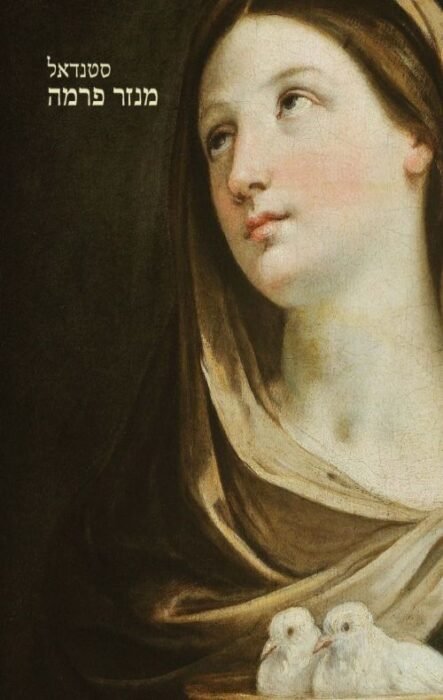For English review, please scroll down.
סטנדאל, בילה שנים רבות באיטליה. לפי אחרית הדבר לספר, אלה היו השנים הסוערות, המאושרות והמיוסרות ביותר בחיו. לכן אין פלא שהרומן "מנזר פרמה" עומד בסימן חוויותיו של הסופר משנים אלה.
עלילת הספר מתרחשת בסוף המאה ה 18 תחילת המאה ה 19 ומתארת את הרפתקאותיו של אציל איטלקי פבריציו דל דונגו.
פבריציו, בנו הצעיר של מרקיז איטלקי, מתגורר על שפת אגם קומו בטירה לא רחוק ממילנו. בתחילת הספר, הצבא הצרפתי כובש את מילנו ומעורר את פבריציו הצעיר והאידיאליסט, להצטרף לצבאו של נפוליון אותו הוא מעריץ.
פבריציו, דובר צרפתית גרועה, מצטייד בניירות מזוייפים ובתכשיטים וכסף שאימו ודודתו נותנות לו ויוצא אל הקרב האחרון של נפוליון בווטרלו. הקרב עצמו מתואר במילים דלות ובסופו פבריציו מוצא עצמו משוטט בצרפת, מפסיד כספים ואף נשדד ונכלא באשמת ריגול. הוא מצליח להימלט בעזרת אישתו של סוהר שהתאהבה בו.
לאחר שהוא חוזר לטירת אביו בקומו, הוא מוצא עצמו בסיטואציה בלתי אפשרית בה אחיו הגדול מוקיע אותו והוא נאלץ שוב לברוח. הבריחה מובילה אותו לפרמה, נסיכות קטנה ובדיונית ושם בעזרת דודתו דוכסית סנסוורינה, מנסה לנתב את דרכו בתככים הפוליטיים בחצרו נסיך פרמה.
דודתו, שהיא גם המאהבת של הרוזן מוסקה, מייעדת לו תפקיד בכיר בצמרת ההגמוניה הדתית בחצרו של הנסיך. פבריציו יוצא לנאפולי, לבית ספר לתיאולוגיה ולאחר מספר שנים שבהן הוא מבלה בחיקן של נשים שונות, הוא שב לפרמה.
ושוב הוא מסתבך עם שחקנית צעירה שהמאהב שלה מנסה להרוג את פבריציו. פבריציו הורג את המאהב ונאלץ לברוח מפרמה מחשש שלא יזכה למשפט צדק. הוא נמצא אשם ונכלא במגדל פרנזה.
דווקא במגדל הוא מתאהב בצעירה בשם קלליה קונטי, בתו של גנרל מהסיעה הליברלית. מחלון הכלא במגדל, רואה פבריציו את קלליה מטפלת בציפורים הכלואות שלה. היא גם מבחינה בקיומו והם מתאהבים. לאחר זמן מה הוא משכנע אותה לתקשר איתו באמצעות אותיות האלפבית המודפסות על גיליונות שנתלשו מהספר.
באותו הזמן, מתכננת דודתו דוכסית סנסוורינה, את בריחתו הנועזת מהמגדל. פבריציו המאוהב מתנגד לתוכניותיה לברוח. אבל לבסוף הוא משתכנע והיא מכריחה את קלליה להבריח אליו שלושה חבלים ארוכים. פבריציו המאוהב מבקש לוודא שיוכל לפגוש שוב את קלליה אבל היא מבטיחה לבתולה שהיא לעולם לא תראה שוב את פבריציו ותעשה כל מה שאביה יגיד.
לאחר בריחתו, קלליה נישאת לאחר. היא ופבריציו חיים שניהם בחוסר אושר.
אבל, זה לא סוף הסיפור – פבריציו חוזר לפרמה בתפקיד סגן הכללי בכנסייה הקתולית. דרשותיו הופכות לשיחת העיר. לאחר ארבעה עשר חודשי סבל של שניהם, קלליה מסכימה להיפגש עמו בלילות, בתנאי שהמפגשים יהיו בחושך.
שנה לאחר מכן היא יולדת את ילדם המשותף. אבל שוב הגורל מתערב וילדם המשותף מת. קלליה מתה כמה חודשים לאחר מכן ולאחר מותה, פבריציו פורש למנזר פרמה, שם הוא מבלה פחות משנה לפני שהוא גם מת. דודתו, שעתה היא הרוזנת מוסקה, שתמיד אהבה את פבריציו, מתה זמן קצר לאחר מכן.
הרומן מסתיים בכינוי "למעטים המאושרים".
"מנזר פרמה" הוא רומן ארוך, מפותל ורבות בו תהפוכות הגורל ותיאורי התככים. הוא בעיקר סיפור אהבה נוגע ללב וסאטירה פוליטית על מעמד האצולה.
באחרית הדבר לספר כותבת לנה שילוני: "ב-4 בנובמבר הסתגר סטנדאל בחדרו והחל להכתיב את הרומן ללבלר מקצועי כשהוא מספר אותו כאחוז דיבוק. […]כעבור 53 ימים של הכתבה קדחתנית היה כתב היד מוכן. היה זה ספר בן 640 עמודים, ומקובל לחשוב שרק הפצרותיו של המו"ל מנעו מן הסופר להמשיך.". טוב זה מאוד ניכר במהלך הקריאה, הקדחתניות הזו.
הבעיה המרכזית בו, שסטנדל מרחיב במילים ותיאורים מיותרים עד כדי זרא. בחלקים שלו הוא פטפטני, בחלקים אחרים משמים ולא היתה מזיקה לו עריכה.
גיבורו של הרומאן, פבריציו, נראה כסוג של קריקטורה: הוא פזיזי, חסר החלטיות, מופקר, חולם בהקיץ על מציאות שלא יכולה להתקיים ואיש דת בעל מוסר מפוקפק. כשהוא יוצא לקרב ווארלו, הוא דמות אידיאליסטית שפועל כנגד אביה השמרני, אבל מאוחר יותר דמותו מקבלת נופך של פלייבוי ריקני ופזיז. תחושת האי נוחות מחריפה כאשר הוא יוצא, בעידוד דודתו, להשתלם ככומר בזמן שהתנהגותו המוסרית מתדרדרת מדחי לדחי.
במהלך הקריאה ניסיתי לאהוב את הספר: את הדמויות והעלילה, אבל התקשתי להתחבר אליהן. הפטפטת והשיעמום שתקפו אותי לפרקים הקשו עלי.
מנזר פרמה/ סטנדאל
הוצאת כרמל, 2008, 400 עמודים
דירוג SIVI –
איכות אודיו –

Stendhal spent many years in Italy. According to the later part of the book, these were the most turbulent, happiest, and tormented years of his life. Therefore, it is no wonder that the novel "Monastery of Parma" represents the writer's experiences from these years.
The book's plot takes place at the end of the 18th century and the beginning of the 19th century and describes the adventures of an Italian nobleman, Fabrizio del Dongo.
Fabrizio, the youngest son of an Italian marquis, lives on the shores of Lake Como in a castle not far from Milan. At the beginning of the book, the French army occupies Milan, inspiring the young and idealistic Fabrizio to join the army of Napoleon, whom he admires.
Fabrizio, who speaks bad French, equips himself with forged papers, jewels, and money given to him by his mother and aunt and goes to Napoleon's last battle at Waterloo. The fight is described in a few words, and at the end, Fabrizio finds himself wandering in France, losing money, and even being robbed and imprisoned for espionage. He manages to escape with the help of a jailer's wife, who falls in love with him.
After he returns to his father's castle in Como, he finds himself in an impossible situation. His older brother denounces him, and he is forced to flee again. The escape leads him to Perma, a tiny and fictional principality, where, with the help of his aunt, the Duchess of Sanseverina, he tries to navigate the political intrigues in the court of the Prince of Perma.
His aunt, who is also Count Muska's mistress, assigns him a senior position at the top of the religious hegemony in the prince's court. Fabrizio goes to Naples, to the school of theology. After several years in which he spends in the bosom of various women, he returns to Parma.
And again, he gets involved with a young actress whose lover is trying to kill Fabrizio. Fabrizio kills the lover and is forced to flee Parma for fear that he will not receive a fair trial. He was found guilty and imprisoned in the Ferenza Tower.
In the tower, he falls in love with a young woman named Kallia Conti, the daughter of a general from the liberal faction. From the prison window in the tower, Fabrizio sees Clelia tending to her caged birds. She also notices his existence, and they fall in love. After a while, he convinces her to communicate with him using the letters of the alphabet printed on sheets torn from the book.
At the same time, his aunt, Duchess Sanseverina, plans his daring escape from the tower. Fabrizio, in love, opposes her plans to elope. But finally, he is convinced, and she forces Kallia to sneak three long ropes to him. The lovesick Fabrizio wants to make sure he can see Calalia again. Still, she assures the virgin that she will never see Fabrizio again and will do whatever her father says.
After his escape, Kallia marries another. She and Fabrizio both live in unhappiness.
But, this is not the end of the story – Fabrizio returns to Parma as Vicar General in the Catholic Church. His sermons become the talk of the town. After fourteen months of suffering for both of them, Kallia agrees to meet with him at night because the meetings will be dark.
A year later, she gave birth to their child. But again, fate intervenes, and their child dies. Clelia died a few months later, and after her death, Fabrizio retired to the monastery of Parma, where he spent less than a year before he also died. His aunt, now Countess Mosca, who had always loved Fabrizio, died soon after.
The novel ends with "for the lucky few."
"Perma Monastery" is a long, winding novel in which the vicissitudes of fate and descriptions of intrigues. It is mainly a touching love story and a political satire on the aristocracy.
In the last part of the book, Lena Shiloni writes: "On November 4, Stendhal locked himself in his room and began dictating the novel to a professional labeler, telling it as if possessed. […] The manuscript was ready After 53 days of feverish writing. It was a 640-page book, And it is common to think that only the publisher's pleas prevented the author from continuing." Well, this is very evident during this feverish reading.
The main problem is that Stendhal expands with unnecessary words and descriptions to the point the reader feels fatigued. In parts of it, he's chatty; in other parts, he's heavenly, and it wouldn't hurt to edit it.
The hero of the novel, Fabrizio, is a caricature: he is reckless, indecisive, promiscuous, daydreaming about a reality that cannot exist, and a religious man of dubious morals. When he battles at Waterloo, he is a romantic character who works against his conservative father. Still, later, his character takes on the air of an empty and reckless playboy. The uneasiness intensifies when he sets out, with his aunt's encouragement, to pay as a priest. At the same time, his moral behavior deteriorates from rejection to rejection.
During the reading, I tried to like the book: the characters and the plot, but I had a hard time connecting with them. The chatter and boredom that attacked me sometimes made it difficult.
לגלות עוד מהאתר Sivi's Books
Subscribe to get the latest posts sent to your email.

